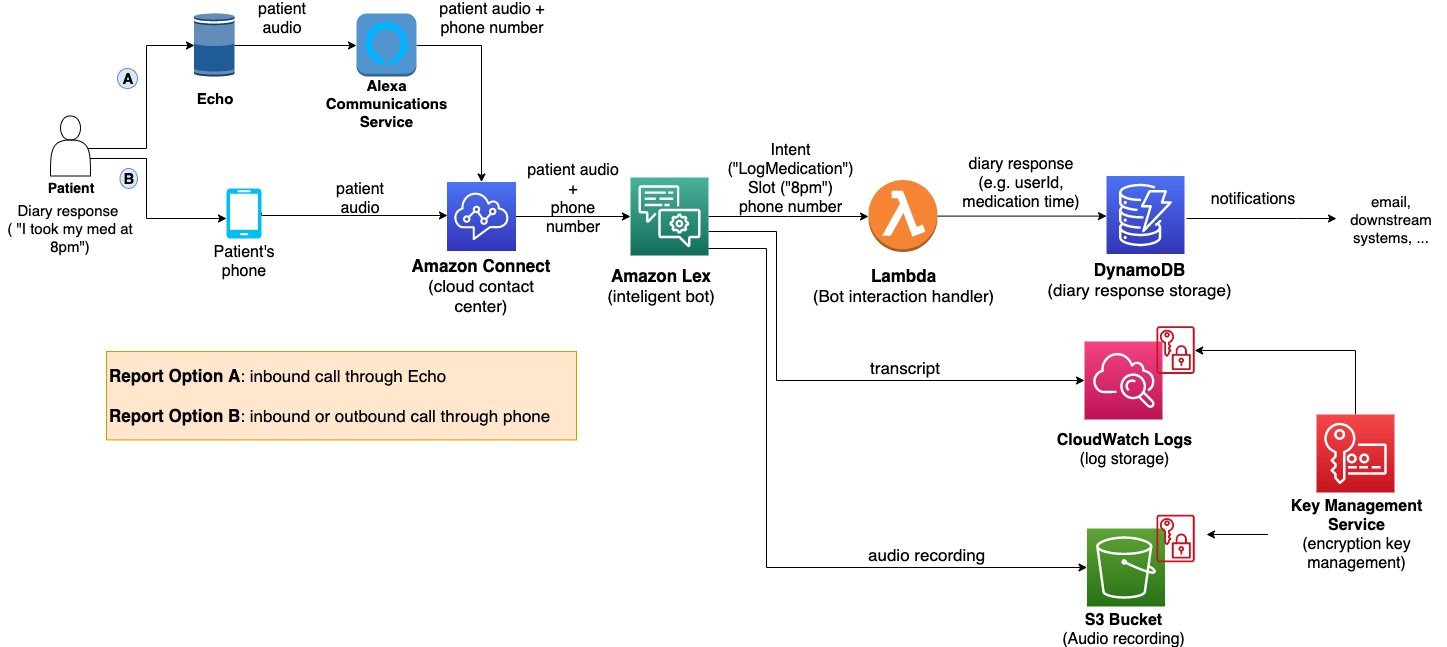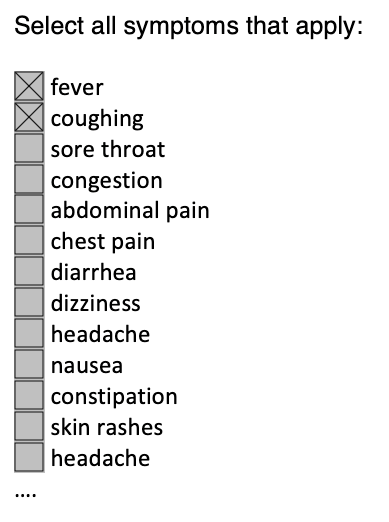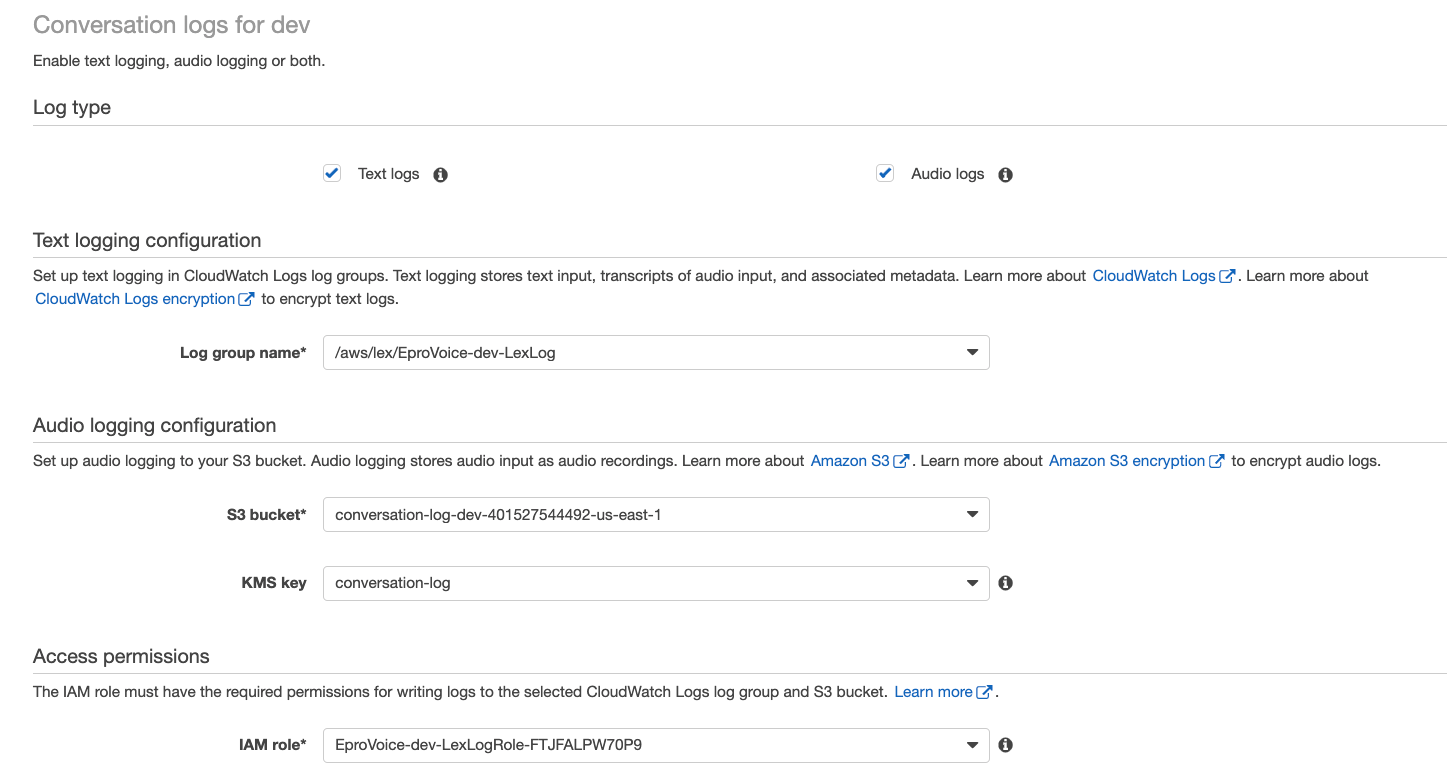AWS for Industries
Voice applications in clinical research powered by AI on AWS – Part 1: Architecture and design considerations
In clinical research studies conducted by the Pharmaceutical industry, electronic clinical outcome assessments (eCOAs) help clinical researchers better understand the effectiveness of the research treatment intervention for research patients. One type of eCOA measure is electronic patient-reported outcomes (ePROs): Health outcome data reported directly by the research patient, typically collected on handheld mobile devices, tablets, or computers. Another eCOA measure is the eDiary: Electronic collection of subjective data from a research patient with automated data entries on a handheld mobile device, tablet, or computer. Studies have shown that compared to paper diaries, eDiaries are more effective at improving patient compliance with the research protocol and therefore generate more accurate data. A popular way to collect diary data has been through mobile phone apps due to the ubiquity of smart phones. Although many patients find it convenient to receive reminders and record information using their smartphones, this approach does not work for everyone. Some patients may have medical conditions such as vision impairments or motion impairments (e.g. Parkinson’s or ALS), making it difficult to enter data on a phone screen. In other clinical trials, researchers may work with patients without sufficient literacy to read the question prompts. For these patients, a system that allows outcome reporting through voice offers a great alternative. Building blocks from AWS such as Amazon Lex and Amazon Connect enable clinical researchers to quickly stand up a hands-free voice interface for patient outcome reporting. By leveraging capabilities built into AWS services, you can build natural, conversational patient experiences using an automated voice reporting system.
The AWS Envision Engineering America’s Prototyping (EE) team co-builds working prototypes to demystify technology and ignite customers’ innovation engines so that they are empowered to invent on behalf of their customers. We recently consulted with PRA Health Sciences, one of the world’s leading global contract research organizations (CRO). Dr. Isaac Rodriguez-Chavez, SVP Head of Global Center of Excellence Decentralized Clinical Trials at PRA, commented, “To make clinical trials more inclusive and less burdensome, PRA is working to incorporate voice enabled technology into research protocols and exploring how the Alexa device can interact with PRA’s Mobile Health Platform to collect quality, regulatory grade clinical trial data. This collaboration supports PRA’s wider initiatives to enable and improve decentralized clinical trials.”
Through a voice interface, the prototype application will verify the patient’s identity, guide the patient to answer a set of questionnaires, and parse and record their responses in a database. Listen to an example of a research patient diary reporting call.
This is the first post of a two-part blog series. In this post, we discuss the architectural and design considerations for building this voice-based patient reporting application.
Solution architecture
The following image shows a high-level architecture and data flow diagram of the voice-enabled patient diary sample implementation. Note that the interaction is two-way in nature:
 Figure 1: Architecture and data flow of the voice patient diary sample application
Figure 1: Architecture and data flow of the voice patient diary sample application
The application supports three different ways for patients to reach the patient dairy voice reporting interface:
- Making an inbound call through their smart phone or landline
- Making an inbound call through a smart speaker such as Amazon Echo
- Receiving an outbound call on their smart phone or landline, initiated by an automated patient outreach scheduler that uses the StartOutboundContact API of Amazon Connect (the outreach scheduler is out of the scope of this blog)
Regardless of which method the patient uses to reach the reporting application, the patient call is handled by Amazon Connect. In this application, the contact flow first greets the patient, then verifies their identity. If successfully authenticated, the flow then checks which questionnaires the patient needs to complete, and collects responses for each questionnaire accordingly.
To support natural language interactions and interpret the patient’s response, the Amazon Connect contact flow delegates each questionnaire to a corresponding Amazon Lex bot. The Amazon Lex service allows you to build conversational interfaces using voice and text. It provides developers the same deep-learning based, conversational AI building blocks that power Amazon Alexa: automatic speech recognition (ASR) for converting speech to text, and natural language understanding (NLU) to recognize the intent of the text. You can build a conversational interface for your application in minutes by supplying a few example phrases for each intent you want to support.
After the Amazon Lex service interprets the patient’s response and parse it into semi-structured data (e.g. medicationTime=‘20:00’), it invokes an AWS Lambda function where you can define custom business logic to react to this information, such as storing in a clinical research database or an EHR system or notifying the principal investigator or the patient’s caregiver if the patient has missed their medication. In the prototype application, the reported information is stored in a set of Amazon DynamoDB tables, and notifications to caretaker/providers are implemented using Amazon Pinpoint.
Voice user interface design considerations
Designing voice user interfaces (VUIs) require a very different approach compared to building graphical user interfaces (GUIs). For example, in a typical web or mobile app, a symptom collection questionnaire is often comprised of a form with a long list of symptoms for which the patient can tick off checkboxes:
 Figure 2: Example symptom reporting form
Figure 2: Example symptom reporting form
Directly translating such a checklist into a voice interface by reading through each option and asking the patient yes or no would surely wear out the patience of any potential users quickly. A best practice in building a natural and user-centric VUI is allowing users to speak in their own words. By leveraging the NLU capabilities provided by Amazon Lex, we can build a VUI so that patients can respond to the question “what symptoms do you have?” in the same way they would talk to a physician, such as “I’m having a headache.”
To build an Amazon Lex bot, you define distinct intents that each represents a meaning the user tries to convey. Then you provide “sample utterances” for each intent, which will be used as training data by Lex to build machine learning models to recognize the correct intent. It’s important to provide a wide range of sample utterances when defining each intent as there may be a variety of ways users could respond to a given question. Testing with users with diverse backgrounds can help identify ways of expression you might not consider otherwise.
However, even with a thorough set of sample utterances in place, the bot could still fail to interpret the user from time to time. You should have a plan for gracefully handling errors. One way to do this is by using the built-in fallback intent from Lex. When the bot could not map the user’s input to any of the custom intents defined in the bot, and a fallback intent is defined, the bot custom logic you define to handle a fallback intent. In our sample application, we programmed the fallback intent for the symptom collection bot to confirm the user’s input by simply repeating it back to them. If the user says “yes”, the system can simply store the entire utterance into the reporting database as a symptom with an “unknown” flag and move on with the conversation. This allows alerting a system admin to review the unknown input after the fact without interrupting the current user reporting flow.
 Figure 3: Example Voice User Interface
Figure 3: Example Voice User Interface
For more tips and design patterns on building great voice user interfaces (VUIs), refer to the VUI design guide from the Amazon Alexa team.
Security and compliance considerations
Collecting and storing patient information may be subject to a variety of regulatory and compliance standards depending on the use case, such as FDA Title 21 CFR Part 11, HIPAA, HITRUST, and SOC, as well as other clinical trial, research confidentiality, and record keeping obligations. While the AWS security home page has a lot of resources for guidance and best practices for securing your AWS workloads in general, in this section, I will highlight a few security and compliance considerations specific to the voice patient reporting application and how to leverage AWS services and features to address them.
Patient authentication
In a typical web or mobile application, developers often implement two-factor authentication by sending a verification code to the user’s email or through a SMS text. Although a similar approach may be implemented in a voice reporting workflow, this functionality may be challenging for many target users of the reporting system to complete: patients with vision or motion impairments who prefer a “hands-free” experience.
In the sample application, user authentication is implemented by verifying two pieces of information from the user: the calling phone number (through automatic number identification, or ANI in short) and a security question they can answer through voice (e.g. asking for their zip code). This is done by passing the ANI phone number to an Amazon Lex bot to look up the patient’s profile and verify their answers to the security question. When used in research, ways in which to manage this information to prevent the revelation of individual is discussed below.
Besides the above-mentioned methods, one additional factor for verifying user identity is through voice biometrics. Although not part of the sample application, there are several voice biometric offerings provided by Amazon Connect technology partners that can be integrated into the application or consider the Amazon Connect Voice ID feature.
Auditability and traceability
At AWS, security is job zero. We can leverage the features of AWS services—relying on the built-in security—to make every request traceable, auditable, and secure. The FDA Title 21 CFR Part 11, which regulates the keeping of electronic records for clinical trials, requires controls in place to “ensure the authenticity, integrity, and, when appropriate, the confidentiality of electronic records”. To provide a secure audit trial of patient records and operator actions, several AWS services and features can be leveraged in combination to make every request to the system auditable and traceable for the architecture outlined above.
A useful feature for Amazon Lex that enables auditability of patient input records and troubleshooting is Lex conversation logs. It supports logging both the text transcript and capturing the audio recording of each user utterance as a separate audio file, supporting identity protection as noted in the following image. The text logs are stored in Amazon CloudWatch Logs, while the audio logs are stored in Amazon S3.
The following image shows the Lex console UI enabling the two types of logs respectively. Note that both the audio and text logs can be configured to use customer managed Amazon KMS encryption keys for additional security compliance.
 Figure 4: Example Lex Console UI Log Configuration
Figure 4: Example Lex Console UI Log Configuration
In addition to Amazon Lex conversation logs, other AWS service and features can add auditability to additional parts of the voice patient diary architecture, all with identity protection features noted:
- Amazon Connect contact flow logs (for capturing the steps that each contact goes through)
- CloudWatch Logs for AWS Lambda Functions (for logging details of the user input processing code)
- AWS CloudTrail (for capturing infrastructure configuration changes)
- Amazon DynamoDB Streams (for capturing changes made to DynamoDB tables)
PII and PHI data protection
As the AWS shared responsibility model for security describes, while the underlying service infrastructure is secured by AWS and verified by a number of compliance programs, the clinical research sponsor or CRO is responsible for securing the application built on AWS. For example, as Amazon Connect invokes AWS Lambda and Amazon Lex on the CRO/sponsor’s behalf, all data exchanged between these services is encrypted in transit by AWS (see Connect and Lex documentation). However, as the CRO/sponsor is in control of where to send and store the patient reported data received by the AWS Lambda function, the CRO/sponsor is responsible for securing its storage and transmission downstream. CROs/sponsors should refer to the HIPAA on AWS, GxP on AWS, and HITRUST on AWS pages for considerations for specific compliance programs that may apply to each use case.
When working with PII (personal information) and PHI (health information) data, CROs and sponsors need to be intentional about where PII data is stored and sanitize sensitive information so they are not unintentionally exposed in logs used for operational purposes. There are a few different types of logs to consider when using Amazon Lex and Amazon Connect.
For Amazon Lex, we discussed the Lex conversation logs feature in the previous section, which adds auditability to Lex bots in your application. If you enable conversation text logs in Lex, one helpful feature for protecting sensitive PII is Slot Obfuscation. When enabled, Amazon Lex replaces the value of the slot with the slot name in conversation logs. You can see this obfuscation in action in the example CloudWatch Logs entry:
 Figure 5: Example CloudWatch Logs entry showing obfuscation
Figure 5: Example CloudWatch Logs entry showing obfuscation
These conversation logs also contain values you store in Lex session attributes. If you store any sensitive PII information in session attributes and do not want them to appear as clear text in logs, you need to encrypt or otherwise obfuscate these values before sending them to the Lex service.
In Amazon Connect, information about each contact are automatically captured in contact trace records (CTR). Data in CTRs powers metrics and reports that you can review to gain insights into your Connect instance. When building your contact flow in Connect, you might use contact attributes to store information about the customer to personalize the experience (similar to the session attribute concept in Amazon Lex discussed previously). For example, you may set the patient’s name as a contact attribute after looking it up in an Amazon Lex bot and then use it to address the patient when playing a question prompt. If you do not want this information to be stored in the CTR record, you can set its value to an empty string to “erase” it before the ending the contact flow.
Summary
In this post, we discussed the architecture and key considerations for building an automated yet human-centric, secure, and auditable application for research patient outcome reporting through a conversational voice interface. For example, this enhances the ability of clinical research sponsors and CROs to understand patients’ experiences with research interventions and encourages compliance by making reporting easier and more accessible to more patients.
In part two of this blog post, we will walk through key components of the sample application and how to set it up in your account.
To learn more about AWS for Healthcare & Life Sciences, visit thinkwithwp.com/health.